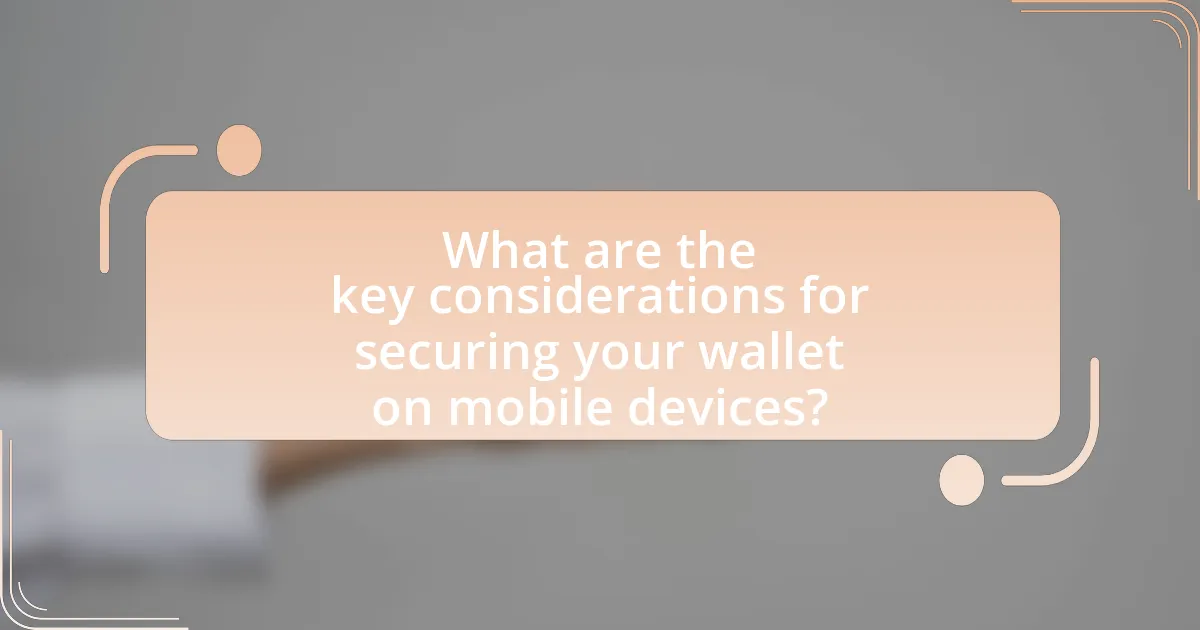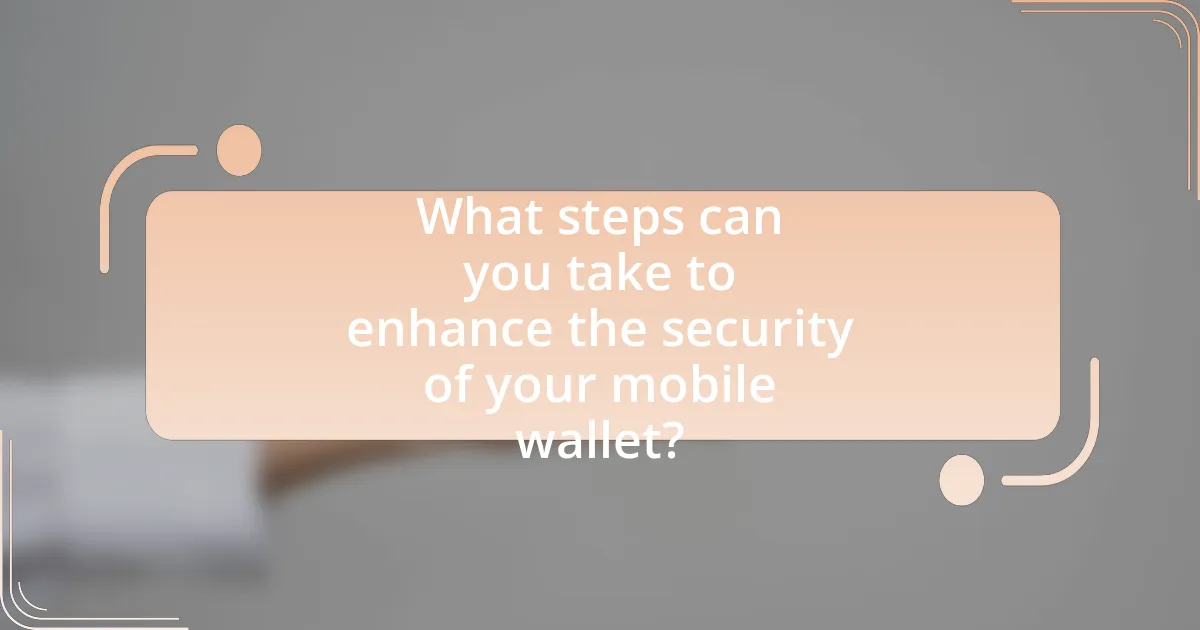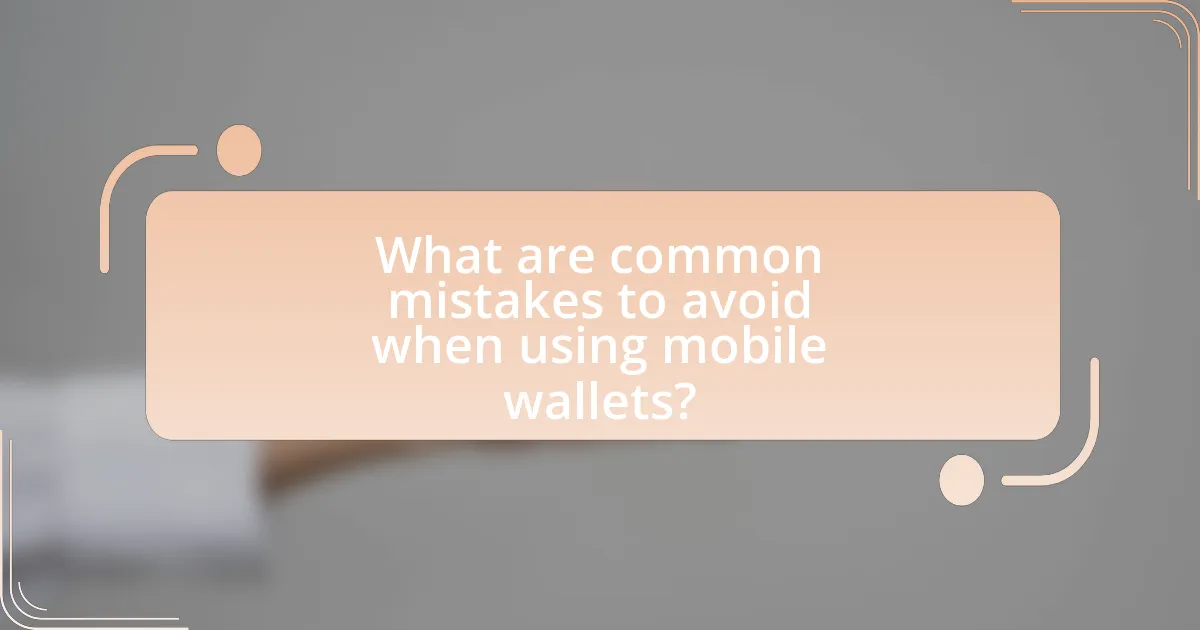The article focuses on securing mobile wallets, emphasizing the importance of strong passwords and two-factor authentication to protect sensitive financial information. It explains how mobile wallets operate, the technologies involved in their security, and the risks associated with unsecured wallets. Key measures for enhancing wallet security, such as regular software updates, biometric authentication, and user vigilance against phishing attacks, are outlined. Additionally, the article discusses common mistakes to avoid and best practices for maintaining security, providing a comprehensive guide for users to safeguard their mobile wallets effectively.

What are the key considerations for securing your wallet on mobile devices?
To secure your wallet on mobile devices, prioritize using strong passwords and enabling two-factor authentication. Strong passwords should be complex, combining letters, numbers, and symbols, while two-factor authentication adds an extra layer of security by requiring a second form of verification, such as a text message or authentication app. According to a study by the Cybersecurity & Infrastructure Security Agency, using two-factor authentication can reduce the risk of unauthorized access by up to 99.9%. Additionally, regularly updating your mobile operating system and wallet app ensures that you benefit from the latest security patches, further protecting your wallet from vulnerabilities.
How do mobile wallets work?
Mobile wallets work by storing payment information securely on a mobile device, allowing users to make transactions electronically. They utilize technologies such as Near Field Communication (NFC) or QR codes to facilitate contactless payments at point-of-sale terminals. When a user initiates a transaction, the mobile wallet encrypts the payment data and transmits it to the merchant’s payment system, ensuring that sensitive information remains protected. According to a report by Statista, the global mobile wallet market is projected to reach over $7 trillion in transaction value by 2025, highlighting the growing reliance on this technology for secure financial transactions.
What technologies are involved in mobile wallet security?
Mobile wallet security involves several key technologies, including encryption, tokenization, biometric authentication, and secure element (SE) technology. Encryption protects sensitive data by converting it into a secure format that can only be read with a decryption key, ensuring that transaction information remains confidential. Tokenization replaces sensitive card details with unique identifiers or tokens, minimizing the risk of data breaches during transactions. Biometric authentication, such as fingerprint or facial recognition, adds an additional layer of security by verifying the user’s identity before granting access to the wallet. Secure element technology provides a tamper-resistant environment for storing sensitive information, further enhancing the security of mobile wallets. These technologies collectively work to safeguard user data and transactions in mobile wallets.
How do mobile wallets store sensitive information?
Mobile wallets store sensitive information by utilizing encryption and secure elements within the device. Encryption transforms data into a secure format that can only be accessed with the correct decryption key, ensuring that sensitive information like credit card numbers and personal identification is protected from unauthorized access. Secure elements, which are tamper-resistant hardware components, provide an additional layer of security by isolating sensitive data and cryptographic keys from the main operating system, making it difficult for malware to access this information. This dual approach of encryption and secure elements is widely adopted in mobile wallet technologies, such as Apple Pay and Google Pay, to safeguard user data effectively.
Why is securing your mobile wallet important?
Securing your mobile wallet is important to protect sensitive financial information from theft and unauthorized access. Mobile wallets store personal data, including credit card numbers and banking details, making them attractive targets for cybercriminals. According to a report by Cybersecurity Ventures, cybercrime is projected to cost the world $10.5 trillion annually by 2025, highlighting the urgency of securing digital financial tools. Implementing security measures such as strong passwords, biometric authentication, and regular software updates can significantly reduce the risk of fraud and identity theft associated with mobile wallets.
What risks are associated with unsecured mobile wallets?
Unsecured mobile wallets pose significant risks, primarily including unauthorized access to funds, data breaches, and malware attacks. Unauthorized access can occur when users do not implement strong passwords or biometric security, allowing hackers to easily exploit vulnerabilities. Data breaches may result from inadequate encryption, exposing sensitive information such as credit card details and personal identification. Additionally, malware attacks can compromise mobile devices, enabling cybercriminals to steal financial data or manipulate transactions. According to a report by the Federal Trade Commission, consumers lost over $1.9 billion to fraud in 2020, highlighting the financial impact of these risks associated with unsecured mobile wallets.
How can data breaches affect mobile wallet users?
Data breaches can significantly compromise mobile wallet users by exposing sensitive information such as credit card details, personal identification, and transaction history. When a data breach occurs, hackers can gain unauthorized access to this information, leading to financial theft, identity fraud, and unauthorized transactions. According to a report by the Identity Theft Resource Center, in 2020, there were over 1,100 data breaches in the United States alone, affecting millions of individuals and resulting in substantial financial losses. This highlights the vulnerability of mobile wallet users to cyber threats, emphasizing the need for robust security measures to protect their financial data.

What steps can you take to enhance the security of your mobile wallet?
To enhance the security of your mobile wallet, enable two-factor authentication (2FA) for an additional layer of protection. Two-factor authentication significantly reduces the risk of unauthorized access by requiring a second form of verification, such as a text message code or authentication app, in addition to your password. According to a study by the Cybersecurity & Infrastructure Security Agency, implementing 2FA can block up to 99.9% of automated attacks, demonstrating its effectiveness in safeguarding sensitive information.
How can you choose a secure mobile wallet app?
To choose a secure mobile wallet app, prioritize apps that offer strong encryption and two-factor authentication. Strong encryption protects your data from unauthorized access, while two-factor authentication adds an extra layer of security by requiring a second form of verification. Research shows that mobile wallets with these features significantly reduce the risk of fraud and data breaches. Additionally, check for regular updates and a good reputation in user reviews, as these factors indicate ongoing security improvements and user trust.
What features should you look for in a secure mobile wallet?
A secure mobile wallet should include features such as strong encryption, biometric authentication, and two-factor authentication. Strong encryption protects sensitive data by converting it into a secure format that can only be accessed with the correct decryption key. Biometric authentication, such as fingerprint or facial recognition, adds an additional layer of security by ensuring that only authorized users can access the wallet. Two-factor authentication further enhances security by requiring a second form of verification, such as a code sent to a registered phone number, before granting access. These features collectively help safeguard against unauthorized access and potential fraud.
How do user reviews and ratings impact wallet app security?
User reviews and ratings significantly impact wallet app security by influencing user trust and developer accountability. High ratings and positive reviews often indicate that an app has been vetted by users, suggesting a lower likelihood of security vulnerabilities. Conversely, negative reviews frequently highlight security issues, prompting developers to address these concerns to maintain their app’s reputation. For instance, a study by the University of California found that apps with higher user ratings are less likely to be associated with security breaches, as developers are motivated to improve security features to retain positive feedback. Thus, user reviews and ratings serve as a critical feedback mechanism that can enhance wallet app security through increased scrutiny and responsiveness from developers.
What security measures can you implement on your mobile device?
To secure your mobile device, implement measures such as enabling biometric authentication, using strong passwords, and keeping your operating system and apps updated. Biometric authentication, like fingerprint or facial recognition, adds a layer of security that is difficult to bypass. Strong passwords, ideally a mix of letters, numbers, and symbols, protect against unauthorized access. Regular updates ensure that your device has the latest security patches, reducing vulnerabilities. According to a report by the Cybersecurity & Infrastructure Security Agency, keeping software updated can mitigate 85% of known vulnerabilities, reinforcing the importance of these security measures.
How does enabling two-factor authentication protect your wallet?
Enabling two-factor authentication (2FA) protects your wallet by adding an extra layer of security beyond just a password. This means that even if someone obtains your password, they cannot access your wallet without the second factor, which is typically a code sent to your mobile device or generated by an authentication app. According to a study by Google, 2FA can block 100% of automated bots and 96% of phishing attacks, significantly reducing the risk of unauthorized access to your wallet.
What role does biometric authentication play in wallet security?
Biometric authentication significantly enhances wallet security by providing a unique and personal method of user verification. This technology utilizes physical characteristics, such as fingerprints or facial recognition, which are difficult to replicate or steal compared to traditional passwords. According to a study by the National Institute of Standards and Technology, biometric systems can reduce the risk of unauthorized access, as they require the physical presence of the user, thereby increasing the overall security of mobile wallets.

What are common mistakes to avoid when using mobile wallets?
Common mistakes to avoid when using mobile wallets include neglecting security features, using weak passwords, and failing to update the app regularly. Neglecting security features, such as two-factor authentication, increases vulnerability to unauthorized access. Using weak passwords makes it easier for attackers to compromise accounts; studies show that 81% of data breaches are due to weak or stolen passwords. Failing to update the app regularly can leave users exposed to security vulnerabilities that developers have patched in newer versions.
How can poor password practices compromise your wallet security?
Poor password practices can significantly compromise wallet security by making it easier for unauthorized users to gain access to sensitive financial information. Weak passwords, such as those that are easily guessable or reused across multiple accounts, increase the risk of hacking. According to a study by the Cybersecurity & Infrastructure Security Agency, 81% of data breaches are linked to weak or stolen passwords. This statistic highlights the critical importance of using strong, unique passwords for each wallet and enabling additional security measures like two-factor authentication to further protect against unauthorized access.
What are the best practices for creating strong passwords?
The best practices for creating strong passwords include using a combination of uppercase and lowercase letters, numbers, and special characters, while ensuring the password is at least 12 characters long. Research indicates that longer passwords significantly increase security; for instance, a password with 12 characters can take billions of years to crack using brute force methods. Additionally, avoiding easily guessable information, such as birthdays or common words, further enhances password strength. Regularly updating passwords and using unique passwords for different accounts also contribute to better security, as highlighted by cybersecurity experts who recommend these strategies to mitigate risks of unauthorized access.
How often should you update your passwords for maximum security?
You should update your passwords every three to six months for maximum security. Regular updates reduce the risk of unauthorized access, as cyber threats evolve and attackers may exploit old passwords. According to the National Institute of Standards and Technology (NIST), changing passwords periodically is a recommended practice to enhance security, especially if there is a suspicion of a breach or if the password has been exposed in a data leak.
What should you do if you suspect your wallet has been compromised?
If you suspect your wallet has been compromised, immediately cease all transactions and access to your wallet. This action prevents further unauthorized access and potential loss of funds. Next, change your wallet password and enable two-factor authentication if available, as these measures enhance security. Additionally, monitor your account for any unauthorized transactions and report them to your wallet provider. According to cybersecurity experts, prompt action can significantly reduce the risk of financial loss and help in recovering compromised assets.
How can you quickly secure your wallet after a breach?
To quickly secure your wallet after a breach, immediately change your wallet password and enable two-factor authentication. Changing the password prevents unauthorized access, while two-factor authentication adds an extra layer of security by requiring a second form of verification. According to cybersecurity experts, implementing these measures can significantly reduce the risk of further unauthorized transactions and protect sensitive information.
What steps should you take to recover lost funds?
To recover lost funds, first, immediately contact your financial institution or service provider to report the loss and request assistance. This step is crucial as many banks and payment services have protocols in place to help recover lost funds, especially if reported promptly. Next, gather all relevant information, such as transaction details and any communication regarding the loss, to provide a clear account of the situation. Additionally, if the loss involves a digital wallet or cryptocurrency, reach out to the platform’s support team for guidance on recovery options. According to a 2021 report by the Federal Trade Commission, timely reporting can significantly increase the chances of recovering lost funds, as many institutions can freeze accounts or reverse transactions if notified quickly.
What are the best practices for maintaining mobile wallet security?
To maintain mobile wallet security, users should implement strong authentication methods, such as biometric verification or two-factor authentication. These methods significantly reduce the risk of unauthorized access, as they require something the user has (like a fingerprint or a code sent to their phone) in addition to their password. According to a study by the National Institute of Standards and Technology, using multi-factor authentication can prevent up to 99.9% of automated attacks. Additionally, users should regularly update their mobile wallet apps and operating systems to protect against vulnerabilities, as software updates often include security patches. Furthermore, it is crucial to avoid using public Wi-Fi networks for transactions, as these networks can be easily compromised, exposing sensitive information. A report from the Federal Trade Commission indicates that over 30% of identity theft cases involve unsecured Wi-Fi connections. Lastly, users should monitor their transaction history frequently for any unauthorized activity, allowing for quick action if suspicious transactions are detected.
How can regular software updates enhance wallet security?
Regular software updates enhance wallet security by patching vulnerabilities and improving encryption protocols. These updates address known security flaws that could be exploited by attackers, thereby reducing the risk of unauthorized access to sensitive information. For instance, a study by the National Institute of Standards and Technology found that timely updates can significantly decrease the likelihood of successful cyberattacks, as they close gaps that malicious actors might exploit. By consistently applying updates, users ensure that their wallets are fortified against emerging threats, maintaining a higher level of security.
What tips can help you stay vigilant against phishing attacks?
To stay vigilant against phishing attacks, regularly verify the authenticity of emails and messages before clicking on links or providing personal information. Phishing attacks often use deceptive tactics, such as mimicking legitimate organizations, to trick individuals into revealing sensitive data. According to the Anti-Phishing Working Group, there were over 200,000 reported phishing attacks in a single month in 2021, highlighting the prevalence of this threat. Additionally, utilizing multi-factor authentication adds an extra layer of security, making it more difficult for attackers to gain unauthorized access even if credentials are compromised.